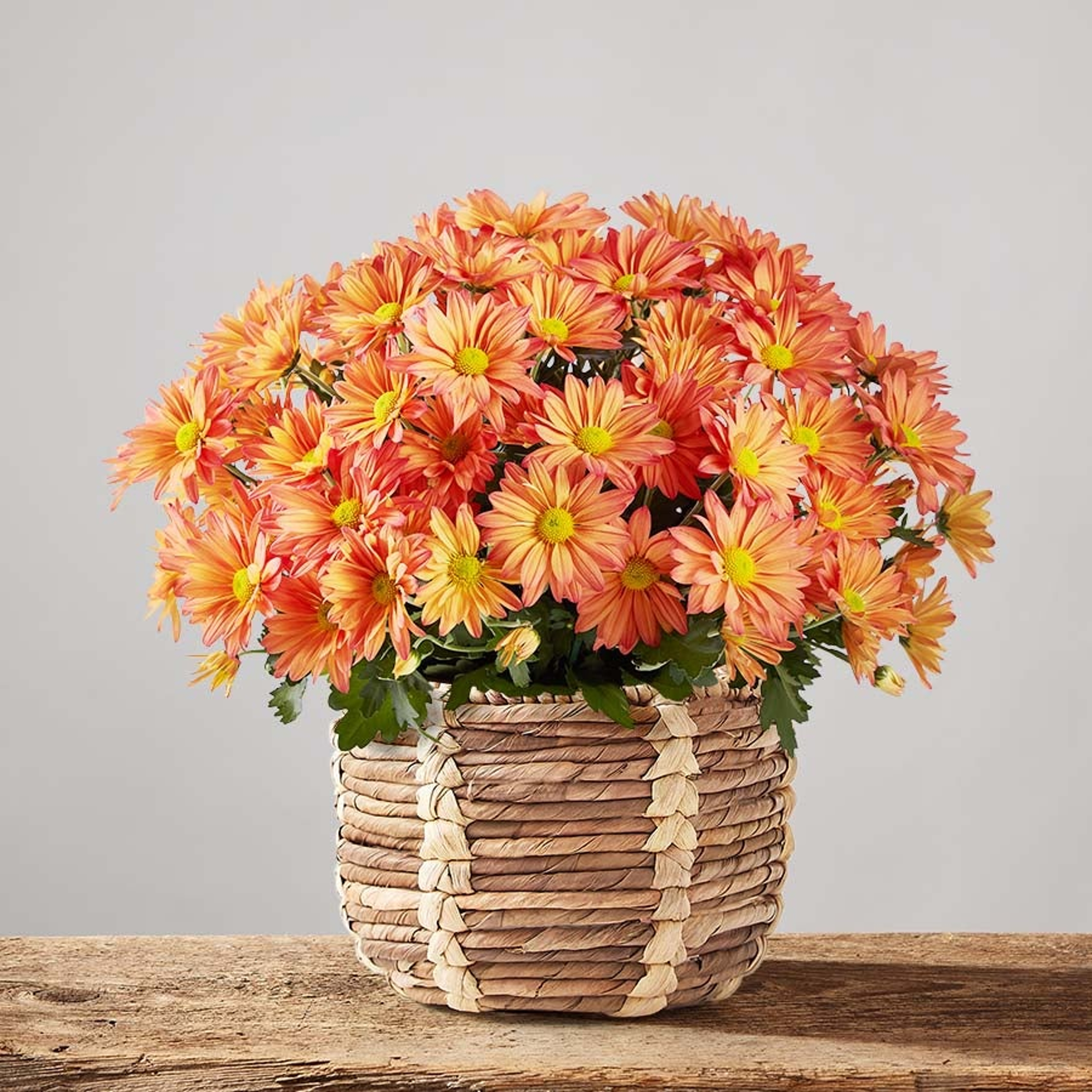Fall Chrysanthemum Care Essentials & Five Fun Facts
Sep 06, 2022
As late summer days grow cool, and gardens start to lose their summer luster, it’s time to fill your home and gardens with chrysanthemums—everyone’s favorite autumn flower. Their long-lasting, showy blooms are held above mounds of fragrant foliage, making them perennial favorites for sunny floral displays.

What Indoor Chrysanthemums Need
We sell chrysanthemums potted and ready to grow. When grown as seasonal indoor specimens, they require full to partial sunlight. Any sunny room will do. Keep the pots evenly moist, but don’t let pots become waterlogged. Excess water is a sure ticket to floral decline and root rot. Cooler room temperatures (65 and 70⁰ F) will encourage the flowers to last longer. Fading blooms turn brown. Remove them as they appear to keep plants looking their best. When the flowers are gone, maintain your florist’s mum in a cool, sunny place through winter—providing it with light water as needed—or compost it. In the spring, it can be planted in the garden to provide further fall beauty.
What Outdoor Chrysanthemums Need
Chrysanthemum-filled gardens and pots provide easy curb appeal until the first hard frost of autumn. They look best planted massed in mixed borders or in festive containers filled with other seasonal flowers, like orange and black pansies, red celosia, and purple asters. Outdoor containers of mums require full sun, quality potting soil, regular water, and look best in attractive well-drained pots. Feeding plants weekly with water-soluble fertilizer, just before and during bloom time, will encourage better growth and flowering. Trim off any spent flowers as you would with indoor specimens. If still in bloom, bring containers indoors before outdoor temperatures drop below 40 degrees F.
In the garden, chrysanthemums thrive in warm sun and fertile garden soil that drains well. Any fertilizer formulated for flowers will help them bloom to their fullest. They make fine perennial additions to the garden, where they are hardy, and look lovely when planted alongside pink Japanese anemones, russet-red celosias, and compact decorative grasses, like blue fescue and Mexican hair grass.
Growing Chrysanthemums as Perennials
Chrysanthemums are perennials, but most have limited hardiness. Traditional seasonal cushion chrysanthemums can survive winter weather in zones 7-9. Gardeners in colder zones must treat them as fall annuals.
When growing chrysanthemums in the garden year-round, expect the clump-forming plants to produce stems of lobed, medium green, fragrant leaves starting in mid-spring. As they grow, pinch back the stem tips, once in late spring and again in midsummer, to maintain a mounding habit and encourage more fall flowers. Chrysanthemums should begin to produce their fragrant blooms by late summer or fall, depending on the variety. In winter, they will die all the way to the ground. Cut back their old stems in spring.
5 Chrysanthemum Fun Facts
- The name Chrysanthemum is derived from two Greek words that translate to “gold flower,” chrysos (gold) and anthemon(flower).
- In the Japanese art of the Thousand Bloom Chrysanthemum(Ozukuri), a single chrysanthemum plant is trained to produce a thousand or more blooms. The largest in the US had over 700 flowers.
- Some spider chrysanthemums can reach 15 inches across or more.
- Tiny gnome chrysanthemums can reach just 8 inches, have tiny flowers, and are trained for bonsai.
- A team of Chinese horticulturists grafted 641 different chrysanthemum varieties together to form one plant--making them the Guiness Book of World Record holders for grafting.
Chrysanthemum Mini History
In addition to being the supreme flower of fall, the sacred Chrysanthemum has a rich, honored, 3000-year cultivation history in its native eastern Asia. In Confucianism and traditional Chinese art, the Chrysanthemum is one of the “Four Noble Ones” or four plants of the seasons, alongside plum blossom (winter), orchid (spring), and bamboo (summer). The ancient flowers symbolize long life and good luck in China, and in Korea they convey integrity and elegance. For hundreds of years the Japanese Imperial Family has used a 16-petaled gold Chrysanthemum as its Imperial Seal, and in Imperial China, Chrysanthemums were reserved for the aristocracy and commoners were forbidden to grow them.
The blooms came westward in 1789 when French botanist Pierre Blancard obtained cuttings after his travels through China. Chrysanthemums gained fast popularity in Europe. In the Victorian-era Language of Flowers, mums came to represent love (red), truth (white), or love scorned (yellow).
Since then, tens of thousands of Chrysanthemum varieties have been bred in a wide array of colors and 13 diverse floral forms—from wildly sinuous spider mums to bristly thistle mums to round pompon mums. Tidy florist’s chrysanthemums with decorative flowers are most common and what we sell. Their fragrant fully double, semi-double or daisy-like single flowers attract bees and butterflies and can be found in nearly all colors of the spectrum except true blue.






